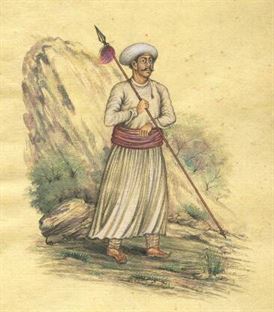
Harkara. Messenger (pp. 298-99)
Solvyns, A Collection of Two Hundred and Fifty Coloured Etchings (1799),
Sec. II, No. 20. “An Hircara.”
Spare a thought for the Harkara or Dak runner who used to deliver messages before the days of post and email.
Ziauddin Barani, (1285–1357) the Tughlaq era historian has recorded the existence of horse and the foot runner for communication in India. Though horses were used for urgent delivery the mainstay of this system was really the foot runner called “Harkara” : postal runner or dak runner. (“Dak” post or mail.)

Camel Harkara or Messenger and A Foot Harkara. Illustration for The World As It Is by George Chisholm (Blackie, 1885).
The runner carried a cleft stick often with ghungroos or bells attached to it which would tinkle as they jogged along and the small bag with the mail was held in this cleft.

Special messages were sometimes sent in silver cases
The Harkaras would light resinous twigs at night to guide them. They just had a stick and spear to defend themselves. In spite of huge personal danger in traveling through forests with wild animals, crossing swollen rivers during monsoons and trekking across snow-capped regions they kept running and delivered the mail. They ran 8-10 miles either way they ran 8-10 miles in each direction and back (i.e. 20 miles a day).
They would also serve as spies and informers bringing intelligence from the areas they travelled to and from especially of rebellious activities.
A painting of a Harkara from the Company School.
The Mughal emperors Babar and Akbar, tried to improve the postal service with Babar regulating horse couriers and Akbar introducing camels for carrying mail to the desert regions. The East India Company and British later established the regular postal service as we know it today. Under the East India Company Harkaras ran 5-6 miles per direction, before handing it over to the next Harkara.
The sarais were also replaced by dak banglows or inns on the dak route where govt officials could rest .
Perhaps these harkaras also got a chance to rest once they handed over their precious cargo to the next runner
A dak banglow in the colonolial era by Lieut.-Col. J. K. Stanford, C.B.E., M.C.

